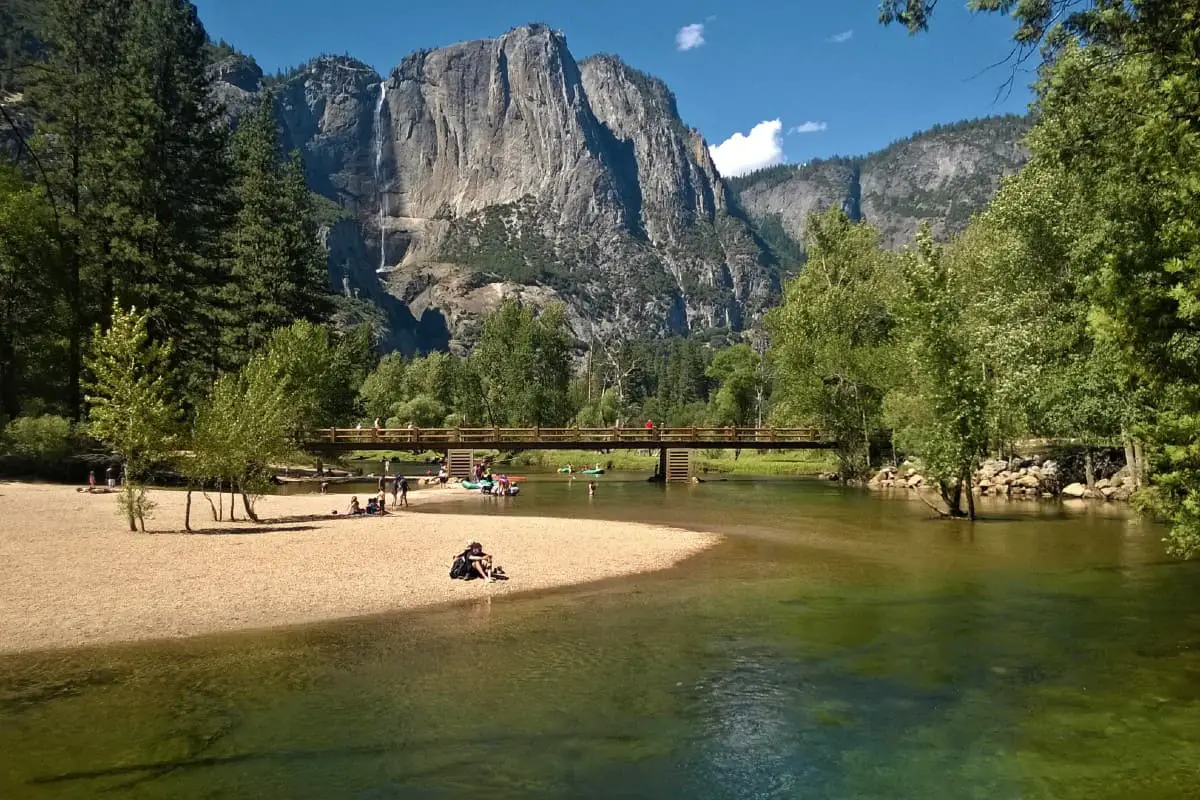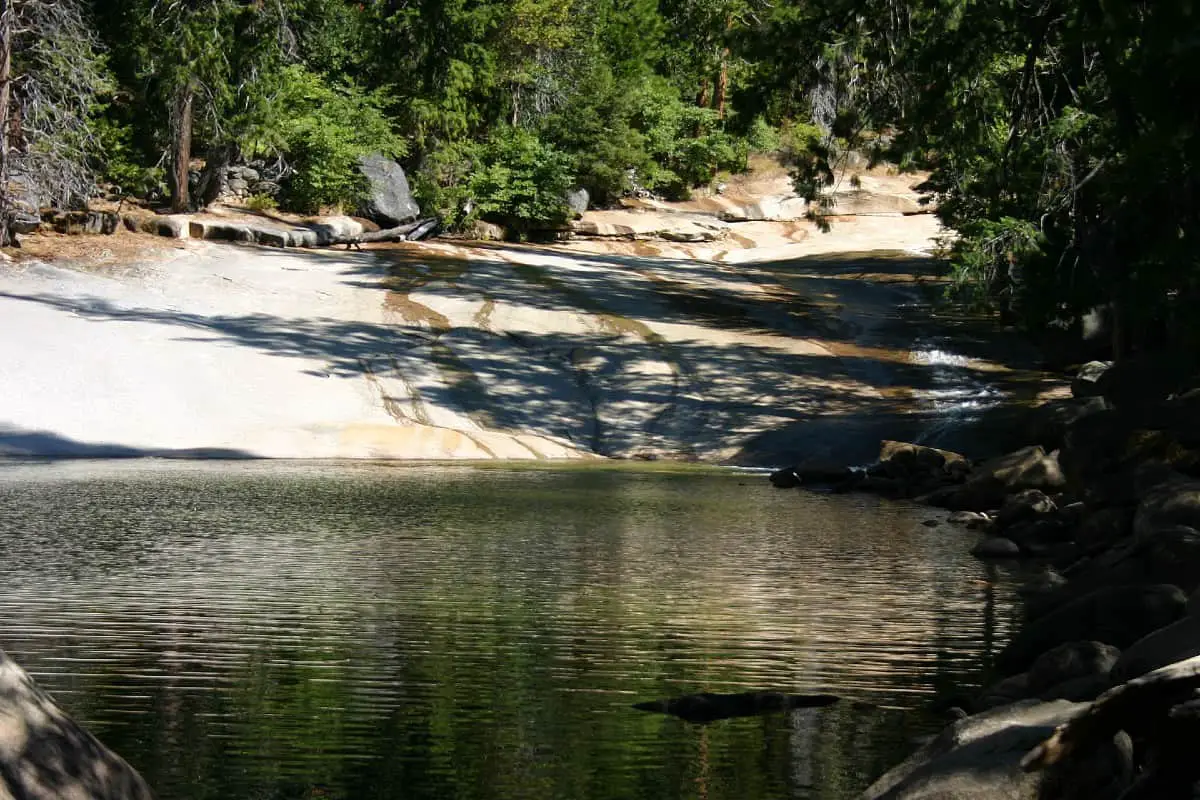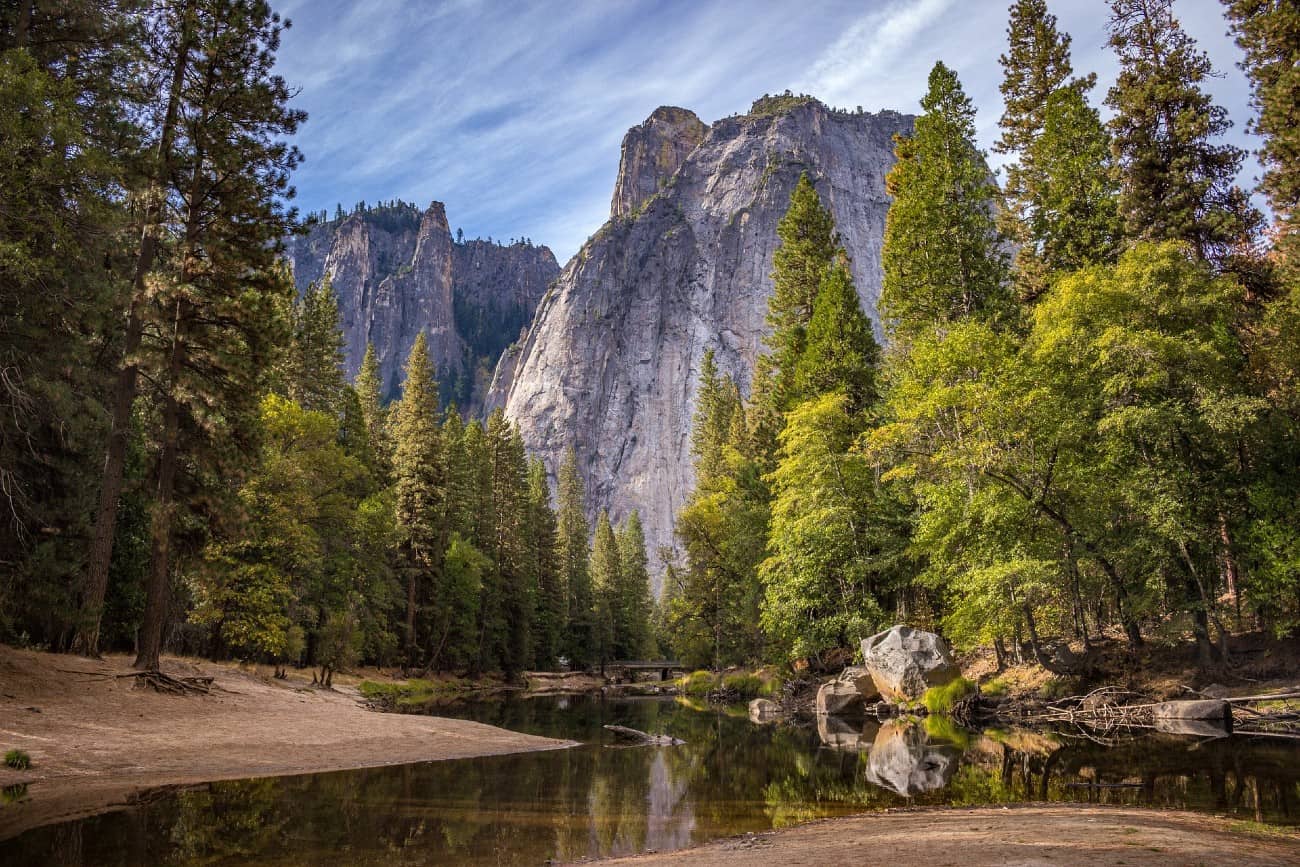Yosemite National Park is known for its imposing Sierra Nevada mountains, outstanding granite rocks, diverse wildlife, and other scenic landscapes irresistible to outdoor enthusiasts. It is also very popular with campers from all over the world. You can actually camp in your car in Yosemite. With so many activities to occupy every kind of outdoor enthusiast, what could be more refreshing than swimming after an adventurous day?
Can you swim in Yosemite National Park? Yosemite National park has natural lakes, rivers, and swimming holes where it is allowed to swim. In some areas, swimming is prohibited or closed because it’s considered dangerous.
In this article, I have compiled everything you need to know about swimming in Yosemite National Park. I have highlighted places where you are allowed to swim and places where you cannot swim. Additionally, I have shared the swimming hazards you need to be aware of and actionable tips to keep you safe.
Where to Swim in Yosemite National Park

Where can you swim in Yosemite National Park? There are numerous swimming areas located in and along Yosemite’s lakes and rivers. These include beaches, swimming holes, waterfalls, and pools where swimming is allowed. Additionally, swimming pools at Yosemite Lodge and Half-Dome village are open to the public for a fee.
Here are specific places where you can swim in Yosemite:
Merced River
Merced River is one of the Rivers that flow through Yosemite, the other one being Tuolumne River. Merced River flows from the Southern part of Yosemite Valley. With various sandy beaches and numerous water holes, the Merced River is one of the best places to swim in Yosemite.
Examples of Merced River’s popular swimming areas include Diana Falls and Swimming Hole, Sentinel Beach, Merced Lake in High Sierra Camp, and Housekeeping Camp Beach.
The best and safest time to swim in Merced River is after early summer (late June), when the water levels are lower, and the temperature is warmer. Also, the river flows at a slower rate, hence reducing the chances of being swept away.
Though not as famous as Merced River, Tuolomne River also comes with places to swim. Great examples? The Carlon Falls and Tuolumne Meadows. Notably, you can only swim safely at the Carlon Falls when the Tuolumne river is calm to avoid being swept off.
Tenaya Lake
Tenaya Lake is one of the most accessible swimming places in Yosemite. For starters, it’s along Highway 120, about 7 miles from Tuolumne meadows and right off the road. Further, it stretches for a whole mile, giving plenty of room and beach access for swimmers.
The lake is located on the higher side of the park and is referred to as the ‘Jewel of the High Country.’ Its beautiful silver-blue water, the surrounding granite rocks, and the pine forest make it one of Yosemite’s best sights.
Given the lake’s location is an elevation of 8150 ft, you better be prepared for a cold swim.
Also, you can only swim in Tenaya lake from May through October. Why? That’s when the seasonal Tioga Pass Road opens. It’s the road through which you access Tenaya Lake from Highway 120.
Other swimmable Yosemite Lakes include the Mirror Lake, Sunrise lakes, Dog’s Lake, and Cathedral Lakes. To access most of them, be prepared to do some hiking.
Wawona Swimming Hole
Wawona is about 7 miles from the South Entrance and about 25 miles from Yosemite Valley. It makes the Wawona section of Yosemite a great place to avoid the crowds. It is also one of the best places to go hiking, swimming, and have a picnic.
Also, don’t forget to enjoy the bouncy feeling of the Swinging Bridge and the fantastic view of the National Park from the top of the bridge.
You can hike the 1.5 miles Swinging Bridge Trail that starts at Chilnualna Falls or start your hike from the Forest Drive and end up on the other end of the bridge, then cool off in the irresistible Wiwona swimming hole.
The best time to swim at the Wawona swimming hole is during summer (June-August) and fall (September -November) when the water is warmer and safer.
Swimming Pools
It is not a reason to skip swimming in Yosemite if you are not exactly a fan of natural swimming places. Some pools are open to the public for a small fee. They are great options if you have kids since the natural water bodies in Yosemite can get cold. At the pools, lifeguards are also available.
Below are two swimming pools where you can take a dip.
Yosemite Lodge Pool
You will find the Lodge near Yosemite Falls. If you are using the Valley Shuttle, it is at stop number 8. The pool gives a perfect view of Yosemite Falls.
Half Dome Village Pool
The pool is also referred to as the Curry Village Pool, and as the name suggests, it is located in Curry Village on the Southeastern side of the Yosemite Village area. When using the Valley Shuttle, stops number 13, 14, and 20 are within a short walking distance to the pool.
Both pools are open every day of the year and are free to use for overnight guests.
Where Not to Swim in Yosemite National

Like I mentioned before, you may not swim in areas of Yosemite that are either closed or prohibited.
These include:
Hetch Hetchy Reservoir
This reservoir is the largest single water body in Yosemite. It was built purposely to provide drinking water to Bay Area residents. Further, it is used to generate hydro-electric power. For this reason, recreational use of the reservoir, which includes swimming, is prohibited.
Emerald Pool and Silver Apron
The Emerald pool has its pool named because of its green color. It gets its color from algae, an aquatic plant that grows at its bottom. The pool is located above the Vernal Falls, about 80 meters away. As such, water flows down to the Vernal Falls at great force. Swimmers in the Emerald Pool have been swept over Vernal falls and died.
Where the Merced River flows into the Emerald pool, there’s a smooth and slopy granite rock referred to as the Silver Apron.
It is common for people to use it to slide into the pool in summer when the water is low, but the activity puts them at risk of sliding into hidden rocks at the other end.
For these reasons, both the Emerald Pool and the Silver Apron are prohibited for swimming and sliding, respectively.
Lake Eleanor Reservoir
You will find the reservoir at a corner on the Northwestern part of Yosemite, the perfect place to spend a quiet time in the back-country. It is usually open for swimming and other water sports from mid-summer through October. However, at the park’s discretion, the reservoir can be closed or opened for swimming at any time. Be sure to check this before heading there.
Other places where swimming is prohibited in Yosemite include Wawona Domestic Water intake, the pool at Yosemite Fall, Dana Fork of the Tuolumne River, and below most waterfalls.
Swimming Hazards and Safety Tips in Yosemite

Regardless of where you are swimming in Yosemite, you might find yourself in trouble if you don’t stay away from common safety hazards or heed warnings.
Did you know that Yosemite park rangers conduct about 250 search-and-rescue operations every year?
Fact: It is safe to go to Yosemite alone. So, whether you are alone or in the company of others, you can ensure that when you take a dip, you do it safely.
I have compiled a list of possible swimming hazards to be aware of and, even better, shared some safety tips.
Common Swimming Hazards in Yosemite
- Thunderstorms – though they are more frequent from June through September, storms can happen anytime in Yosemite. It includes heavy rain, hail, and lightning strikes, leading to hypothermia, injuries, or even death.
- Microbes – these are disease-causing microorganisms that operate in open water sources. In Yosemite, Giardia Lambria is a common microbe known to cause an intestinal disease called Giardiasis. It can get into your body if you happen to swallow the water you are swimming in.
- Cold – Water in alpine or high altitude areas such as Yosemite is cold. Spending too much time in the water can lead to hypothermia.
- Swift Water – swift water is water that moves at a speed faster than 1.15 miles/hour. It’s common in Yosemite, especially when the water levels are high.
- Unpredictable dangers include washed-off rocks and logs, sudden currents, and flash floods, among others.
Tips to Stay Safe While Swimming in Yosemite
- When swimming in rivers, avoid rushing water and strong currents and contain yourself to calm water.
- Avoid spending too much time in the water to avoid hypothermia and keep warm clothing and a towel nearby.
- Do not ignore closure and prohibition notices. Notably, some swimming areas close and open at certain times of the year while other places are ultimately prohibited for swimming.
- Avoid drinking/ swallowing water while you swim in Yosemite to protect yourself from disease-causing microorganisms.
- When swimming, avoid hopping or climbing on rocks as they might be slippery, leading to slips and falls.
- Look out for signs of storms such as heavy dark clouds, strong winds, and a drop in temperatures, and move away from water and higher ground.
- Always swim within the designated swimming areas.
- Do not swim at or below the waterfalls.
Final Words
There are numerous places to swim in Yosemite and a few other places where swimming is prohibited. If you can keep to the right places and practice the above safety tips, you will have a great swimming experience in the park.
If you plan on camping in Yosemite, better be prepared with bug spray. There are numerous mosquitoes and bugs in Yosemite National Park.
Related: A Complete US National Park List


